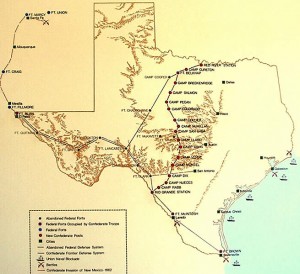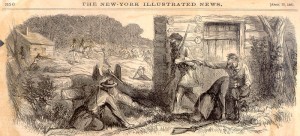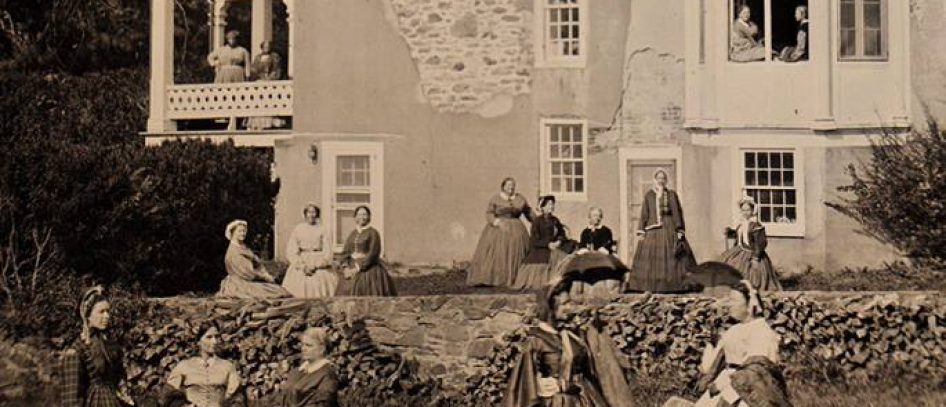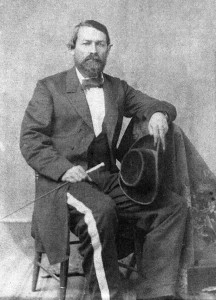 With the expulsion of Federal troops from Texas, it fell on the Texas government to defend the hundreds of miles of state border and coastline. Texas now not only had to supply men to fight in the Confederate army but also find enough men to protect the citizens in the frontier from Native Americans such as the Comanche, Kiowa, and Kickapoo, who fiercely fought against the settlers’ encroachment into their territory.
With the expulsion of Federal troops from Texas, it fell on the Texas government to defend the hundreds of miles of state border and coastline. Texas now not only had to supply men to fight in the Confederate army but also find enough men to protect the citizens in the frontier from Native Americans such as the Comanche, Kiowa, and Kickapoo, who fiercely fought against the settlers’ encroachment into their territory.
Counties in the north of Texas and as far south as Austin and the Hill Country experienced Indian raids similar to this one described in the Galveston News in 1864:
Montague, Dec. 29, 1863.
Ed News.—The Indians came down to this country the other day and stole several head of horses, keeping down Red River right along the big road until they got into Cooke county. There they killed six persons, one man, two women and three children, and stole all the horses they could get. They then kept down the river some distance, when they made straight for the Gainsville settlements, going within four miles of Gainsville. The soldiers, about forty in number, came up with them, when the Indians, numbering some 200, charged them, compelling them to retreat, with the loss of two or three killed and one mortally wounded.1
In an attempt to protect several counties, Governor Lubbock exempted men in frontier counties from the Confederate draft. Three separate regiments were created to protect Texas civilians from Indian raids. Apparently few civilians felt comfort in their presence as voiced by a letter in the Galveston News, in 1863 “If the Frontier Regiment keeps on hauling cotton, making dancing parties, visiting their friends and relatives, &c., &c., it may as well be disbanded at once…”2
 Many civilians in the frontier regions relied on “forting up”, gathering at stockades or ranch houses for protection. Others simply left the area as described by a citizen in 1863 “While I pen this I see my neighbors in a long and mournful procession passing my farm, looking back with tearful eyes to catch a last glimpse of their comfortable houses in our beautiful valley. The highways and byways are strewn with the wreck and debris of a ruined and retreating country.”3
Many civilians in the frontier regions relied on “forting up”, gathering at stockades or ranch houses for protection. Others simply left the area as described by a citizen in 1863 “While I pen this I see my neighbors in a long and mournful procession passing my farm, looking back with tearful eyes to catch a last glimpse of their comfortable houses in our beautiful valley. The highways and byways are strewn with the wreck and debris of a ruined and retreating country.”3
The frontier regiments were eventually disbanded or absorbed into Confederate service and Indian raids continued through the Civil War.
Along the Mexican border, Union agents were recruiting Tejanos and Mexicanos to conduct raids across the border occupying large number of
Confederate troops. Beginning in December 1862 Octaviano Zapata, an ally of Juan Cortina, began raiding Confederate supply wagons and stealing cattle. Several civilian and military deaths occurred before Zapata was killed. In addition, Cortina was assisting Texas Unionists and the Federal government from Mexico.
Further up the Gulf Coast Federal troops were threatening and partially succeeding in the invasion of Texas. The citizens of Gulf Coast communities such as Galveston, Corpus Christi, Indianola, and Lavaca learned to live in occupied and blockaded territory.
1 Galveston Weekly News. January 20, 1864, page 1, column 4
2 Ibid. August 5, 1863, page 1, column 7
3 Ibid. July 29, 1863, page 1, column 1

